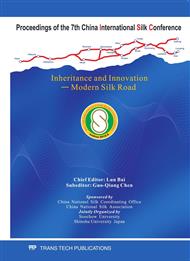p.13
p.19
p.25
p.30
p.36
p.41
p.46
p.51
p.56
Determination of DNJ of Mulberry Latex and Evaluation of the Hypoglycemic Effect on Mice
Abstract:
Mulberry trees (Morus spp. Moraceae) are used for rearing the silkworm. Moraceae plants are characterized by the presence of latex, and mulberry trees exude latex when their stem, leaf or root were damaged. We found in the present study that mulberry latex contains very high concentrations of DNJ (0.63% wet weight, 4.5% dry weight), the DNJ content of latex varied with different part of tree and collecting time. The study also evaluated the antihyperglycemic effects of mulberry latex on streptozotocin induced diabetic mice. Diabetic mice were treated with mulberry latex or acarbose with food for 21 days. The results indicated that postprandial blood glucose and fasting-blood glucose level of mice were lowed, mulberry latex displayed a significant reduction ( P ≤ 0.05) in blood glucose. This finding suggested that mulberry latex have high value for herbal medicine as hypoglycemic function.
Info:
Periodical:
Pages:
36-40
Citation:
Online since:
January 2011
Authors:
Keywords:
Price:
Сopyright:
© 2011 Trans Tech Publications Ltd. All Rights Reserved
Share:
Citation:


